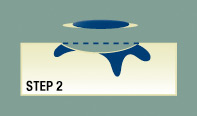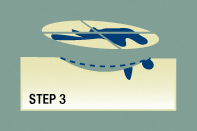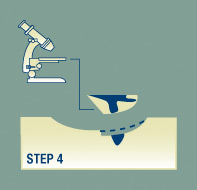FOR PATIENTS
The Mohs Step-by-Step Process
The Mohs surgery procedure seems simple: the surgeon removes the cancer, carefully checks to be sure the he or she got it all, then repairs the wound. American College of Mohs Surgery members, however, train in and practice the complex nuances of this process for years so they are prepared to handle any situation they may encounter. This page describes the steps they follow for each Mohs surgical procedure.
Mohs skin cancer surgery is the most effective treatment for most types of skin cancer. To learn more about your options, find a fellowship trained Mohs surgeon in your area.
Step 1

The roots of a skin cancer may extend beyond the visible portion of the tumor. If these roots are not removed, the cancer will recur. A surgery starts with the American College of Mohs Surgery (ACMS) specialist examining the visible lesion and planning what tissue to remove. The patient then receives local anesthesia, and the Mohs surgery begins.
Step 2

The surgeon removes the visible portion of the tumor using careful surgical techniques.
Step 3

The ACMS surgeon next removes a deeper layer of skin and divides it into sections. With the help of technicians, the surgeon then color-codes each of these sections with dyes and makes reference marks on the skin to show the source of the sections. A map of the surgical site is then drawn to track exactly where each small portion of tissue originated.
Step 4

In a laboratory, the surgeon uses a microscope to examine the undersurface and edges of each section of tissue in search of evidence of remaining cancer.
Step 5

If the surgeon finds cancer cells under the microscope, he or she marks their location on the "map" and returns to the patient to remove another deeper layer of skin — but only from precisely where the cancer cells originated. This method ensures that the Mohs surgery results in the smallest scar possible.
Step 6
The removal process stops when there is no longer any evidence of cancer in the surgical site. Because Mohs surgery removes only tissue containing cancer, it ensures that the maximum amount of healthy tissue is kept intact.
At this point, the surgeon discusses reconstruction options, should they be required, and then post-operative care. Mohs surgery recovery tends to be easily manageable because of the use of local anesthesia and the careful surgical techniques.


